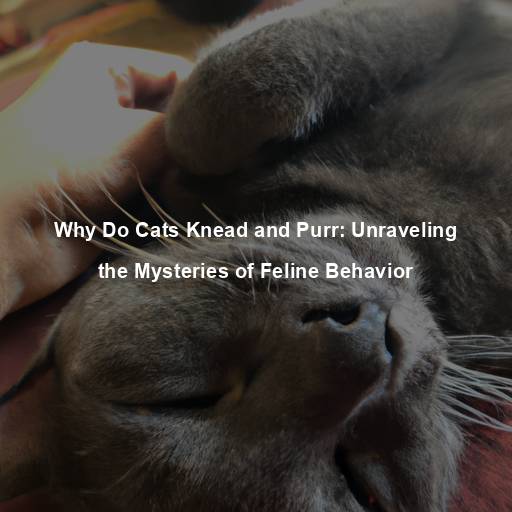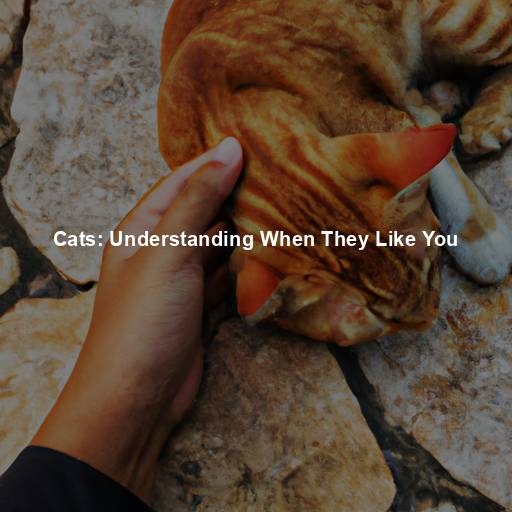Why Do Cats Sleep on You: Understanding the Feline Affection
Last Updated on October 18, 2023 by Evan
Contents
- 1 The Fascinating Mystery of Feline Sleeping Habits
- 2 The Science Behind Feline Sleeping Patterns
- 3 Creating a Sleep-Friendly Environment for Your Feline Friend
- 4 The Joy of Feline Companionship
- 5 Creating an Ideal Sleep Environment for Your Cat
- 6 The Beauty of Feline Slumber
- 7 FAQs: Why Cats Sleep on You
- 7.1 Why do cats always choose to sleep on me?
- 7.2 Why does my cat sleep on specific parts of my body?
- 7.3 Is it normal for cats to sleep on their owners?
- 7.4 Why does my cat sleep on me at night but not during the day?
- 7.5 How can I encourage my cat to sleep in its own bed instead?
- 7.6 Is it safe to let my cat sleep on me?
The Fascinating Mystery of Feline Sleeping Habits
It’s fascinating to witness how cats effortlessly find solace in the most unexpected corners of our living spaces. Whether it’s a plush bed or a patch of sunlight, these enigmatic creatures possess a remarkable knack for discovering the coziest havens. But what truly perplexes and warms our hearts is their peculiar inclination to slumber on their human counterparts. What drives these cuddly felines to curl up on our laps or nestle beside us during the night?
A Warmth and Security Connection
Have you ever wondered why your feline companion insists on turning you into their own personal bed? It turns out that there might be more to it than just their love for cuddles. Cats have an innate desire for warmth and security, and what better way to fulfill that than by snuggling up to a cozy human body? Your comforting presence not only provides the warmth they crave but also creates a sense of safety with your familiar scent and soothing breaths.
The Bond of Trust and Affection
Cats, these enigmatic creatures of the feline realm, possess a complex duality that never fails to bewilder us. Behind their veil of independence lies a hidden desire to forge profound connections with their human counterparts. A cat’s nocturnal journey, meandering through the abstractions of sleep, takes a breathtaking twist when they decide to grace us with their presence. This choice, seemingly random yet infused with purpose, serves as a poignant reminder of the trust they have bestowed upon us, an undeniable affirmation of their deep affection and emotional bond.
Marking Territory: You Belong to Them
Cats, those enigmatic creatures of habit, have their captivating ways of staking their claim on everything under the sun. From their sophisticated way of expressing possessiveness to their unique scent-marking rituals, they have an intriguing repertoire of territorial behavior. When a cat nestles upon you with serene slumber, it’s not just an ordinary nap; it’s a peculiar declaration of ownership. Through secretions left subtly on your person, they are bequeathing a potent message to their feline counterparts: “This human is MINE”!
Seeking Comfort and Companionship
Just like humans, cats seek comfort and companionship. When they curl up on your lap or snuggle close to you, they are seeking both physical and emotional warmth. Your body provides a soft and cozy spot for them to rest, while your presence offers the companionship they crave. Cats are social animals, and they often form strong attachments to their human caregivers.
The Science Behind Feline Sleeping Patterns
Now that we’ve explored the reasons behind why cats choose to sleep on their human companions, let’s delve into the intriguing science behind their sleeping patterns. Cats are known for their love of napping, and they have some fascinating sleep habits that contribute to their overall well-being.
Polyphasic Sleep: The Art of Power Napping
Unlike humans who typically have a monophasic sleep pattern, cats are masters of polyphasic sleep. This means that they have multiple sleep and wake cycles throughout a 24-hour period. On average, cats sleep for approximately 12-16 hours a day, with short bursts of deep sleep followed by periods of light sleep. This unique sleep pattern allows them to conserve energy while remaining alert to potential threats in their environment.
REM Sleep: The Dreaming Phase
Just like humans, cats experience REM (Rapid Eye Movement) sleep, which is the phase associated with dreaming. During REM sleep, a cat’s brain activity increases, and their eyes move rapidly beneath their eyelids. It is during this phase that cats may twitch, purr, or even let out soft mews as they engage in dream-like experiences. It is both fascinating and heartwarming to observe your feline friend in the midst of their dream adventures.
The Sleep-Wake Cycle: Crepuscular Creatures
Have you ever wondered why cats seem to have endless bursts of energy just when you’re ready to wind down? Well, it turns out our feline friends have a mysterious sleep-wake rhythm that keeps them on their tippy toes during those magical hours of dawn and dusk. While we may find solace in long, uninterrupted slumbers at night, our furry companions prefer to stack up their Z’s during the day, only to wreak havoc with their playful antics when the world is shrouded in dim light. By understanding and respecting their enigmatic sleep patterns, we can create a purr-fect environment that caters to their needs and guarantees their ultimate well-being and fulfillment.
Creating a Sleep-Friendly Environment for Your Feline Friend
Now that we have gained a deeper understanding of why cats choose to sleep on their human companions and the science behind their sleeping patterns, let’s explore how we can create a sleep-friendly environment for our feline friends.
Provide Cozy Sleeping Spots
Cats appreciate having a variety of cozy sleeping spots throughout your home. Consider providing them with comfortable beds, blankets, or even dedicated cat towers where they can curl up and rest undisturbed. Placing these sleeping spots in quiet areas away from high traffic zones will ensure that your cat can enjoy uninterrupted sleep.
Respect Their Personal Space
When it comes to sharing a snooze with your furry feline, the lines of feline etiquette can sometimes leave us scratching our heads. As much as we adore their cozy company, it’s crucial to embrace their independent nature. Pushing our affections upon them when they seek solitude might cause them to feel overwhelmed or nervy. Respecting their personal preferences and watching their subtle cues will ensure we’re offering them the purrfect level of personal space.
Establish a Consistent Routine
Cat’s lives are complete enigmas, filled with endless bursts of energy and perplexing behaviors. These mysterious creatures find solace in routines, especially when it comes to their slumber. To ensure their utmost well-being, it is crucial to establish a structured sleep schedule that instills a sense of security and rejuvenation. Consistency in feeding and playtime, harmoniously intertwined with engaging activities, will effortlessly harmonize their sleep-wake cycle, unveiling a state of blissful rest.
Create a Calming Environment
Cats are sensitive to their surroundings, and creating a calming environment can greatly enhance their sleep quality. Provide them with a quiet and peaceful space where they can retreat for their naptime. Consider using soft lighting, ambient sounds, or even calming pheromone diffusers to create a serene atmosphere that promotes relaxation.
Consult with a Veterinarian
Has your feline friend been acting peculiar lately? Perhaps their sleep patterns have taken a strange turn, leaving you perplexed and concerned. But fear not, for the answer to this enigma lies within the expert hands of a veterinarian. Seek their advice to unravel the mysteries behind your cat’s unrestful slumber and ensure their health and well-being.
The Joy of Feline Companionship
As our journey through the enigmatic world of feline slumber reaches its finale, it is crucial to recognize the sheer delight and satisfaction that stems from the deep connection we form with our furry companions. Whether it be the pursuit of warmth, an unquenchable thirst for affection, or a subtle declaration of ownership, the enigma of why cats choose to rest on us remains a perplexing phenomenon. Embrace and treasure these instances of felicitous feline camaraderie, for they symbolize the remarkable alliance between humans and their devoted and endearing pets.
In our journey to understand the mysteries of the feline world, we have unraveled the reasons behind why cats sleep on their human companions. From warmth and security to trust and affection, their choice to slumber by our side is a heartwarming testament to the deep bond we share. So the next time your cat curls up on you for a nap, embrace the warmth, cherish the connection, and savor every precious moment of feline love. After all, there’s nothing quite like being chosen as a sleeping spot by your beloved feline friend.
Now that we’ve explored the reasons behind why cats choose to sleep on their human companions, let’s delve deeper into the fascinating science behind their sleeping patterns. Understanding the intricacies of feline sleep can help us provide the best care for our furry friends.
Polyphasic Sleep: Napping Experts
Cats are renowned for their love of napping, and their sleep patterns are a testament to their prowess in the art of slumber. Unlike humans, who generally follow a monophasic sleep pattern with one long sleep period, cats are masters of polyphasic sleep. This means they have multiple sleep and wake cycles throughout a 24-hour period. On average, cats sleep for approximately 12-16 hours a day, allowing them to conserve energy while remaining alert to potential threats in their environment.
REM Sleep: Dreaming Felines
Did you know that cats, just like us, have their own version of dreaming? It’s called REM (Rapid Eye Movement) sleep, and it’s a fascinating phenomenon. During this peculiar stage, a cat’s brain activity surges and their closed eyes start to flicker rapidly. You might even catch your furry friend twitching, purring, or making adorable little mews as their dreams take shape.
Light Sleep: Vigilant Guardians
Cats, those enigmatic creatures of the night, are more than just master nappers. As they drift into the realm of slumber, their sleep is a delicate dance between deep rest and heightened awareness. In this mysterious state, their senses remain on high alert, guarding against the unexpected. With the slightest disturbance, they awaken like a coiled spring, ever watchful, ever ready to defend their territory.
Circadian Rhythm: Crepuscular Creatures
Cats are considered crepuscular creatures, meaning they are most active during the twilight hours of dawn and dusk. This natural behavior is a result of their evolutionary history as nocturnal hunters. While they may adjust their activity patterns to some extent to align with their human household, their innate circadian rhythm still influences their sleep-wake cycle. Understanding their natural tendencies can help us create an environment that supports their needs.
Creating an Ideal Sleep Environment for Your Cat
Now that we have a better understanding of feline sleep patterns, let’s explore how to create an ideal sleep environment for our beloved cats. Ensuring they have a comfortable and peaceful space to rest will contribute to their overall well-being.
Cozy Beds and Hideaways
Ensuring your feline companion’s sleep sanctuary is nothing less than purrfection is a key ingredient for their ultimate comfort. These discerning creatures revel in a plethora of choices, embracing the luxuriousness of soft beds, the snuggle-worthy allure of plush blankets, or even the secluded charm of dedicated cat caves. These inviting havens not only cocoon them in a cocoon of tranquility but also evoke a cozy ambiance that dances with warmth. Indulge their regal preferences by exploring an array of bed designs and sumptuous fabrics, allowing serendipity to lead you to their ideal slumber haven.
Location, Location, Location
When it comes to the feline domain, one must carefully contemplate the chosen slumber location. These enigmatic creatures thrive on solitude, yearning for an elusive hideaway. Cast away the notion of situating their cozy abodes in bustling thoroughfares or next to boisterous contraptions. Instead, favor a tranquil alcove or an undisturbed chamber, ensuring their sleep is unperturbed.
Temperature and Humidity
Cats are highly sensitive to temperature and humidity levels. Ensure that their sleep environment is neither too hot nor too cold, as extreme temperatures can disrupt their sleep. Optimal room temperature for cats generally ranges between 68-75°F (20-24°C). Additionally, maintaining proper humidity levels can prevent dry skin and respiratory issues.
Darkness and Light
Cats are crepuscular animals, meaning they are naturally active during low-light conditions. While they can adjust their activity patterns to accommodate their human companions, it’s important to provide them with a dark and quiet sleep environment. Consider using blackout curtains or shades to minimize external light sources, particularly during their designated sleep hours. This will help create an atmosphere conducive to restful sleep.
Establish a Bedtime Routine
Cats are captivating creatures who, much like us, thrive on the magic of a structured nighttime ritual. By crafting a regular sequence of pre-slumber activities, we can tap into their feline essence and create an air of tranquility. Encourage their serenity by embarking on serene adventures like tender playtime or soothing grooming sessions, leading up to a serene interlude before bed. This enchanting routine will guide them towards a harmonious slumber, as they learn to cherish these peaceful moments as their own lullabies.
Minimize Disturbances
Cats are light sleepers, and even small disturbances can disrupt their rest. Minimize potential disruptions by providing them with a quiet sleeping environment. If you have other pets or young children, ensure they understand the importance of allowing your cat to sleep undisturbed. Creating a designated quiet space for your cat’s sleep can also help avoid unnecessary interruptions.
The Beauty of Feline Slumber
As we wrap up our deep dive into the mysterious realm of feline slumber and the art of crafting a purrfect sleep haven, let’s pause and marvel at the sheer elegance of our kitty friends’ snooze sessions. The way they effortlessly find solace and serenity in their surroundings truly leaves us in awe, a gentle reminder of their remarkable adaptability and the profound trust they bestow upon us, their loving guardians. By offering them an environment conducive to quality shut-eye, we not only safeguard their overall welfare, but also nurture the profound connection we share with these enigmatic furry beings.
As we observe our feline friends basking in the comfort of their own little havens, it’s impossible not to marvel at the tranquility they exude in their slumber. Let’s pause and appreciate these precious instances, acknowledging the indescribable joy they bring into our existence. By unraveling the intricacies of their individual sleep patterns and curating a haven tailored to their needs, we nourish their sense of contentment and ensure they receive the uninterrupted repose they so rightfully deserve.
May the comforting symphony of gentle purrs and blissful slumber echo through the corridors of your cherished abode, as your beloved feline companions set sail on enchanting voyages within the ethereal realm of dreams.
FAQs: Why Cats Sleep on You
Why do cats always choose to sleep on me?
Cats have a natural instinct to seek warmth and comfort. They perceive humans as sources of warmth, especially when we are lying down and providing a soft, cozy surface. Additionally, cats are social animals and enjoy being close to their loved ones. Sleeping on you allows them to feel safe and secure, as they can sense your presence and relax in your company.
Why does my cat sleep on specific parts of my body?
Cats, those enigmatic creatures of the feline realm, possess a mysterious knack for selecting their slumber sanctuaries, piquing our curiosity and leaving us perpetually wondering about their preferences. With a captivating blend of individual instinct and unique needs, these fickle felines artfully choose their sleeping spots like connoisseurs of comfort. Some feline friends may opt for the grandeur of snuggling up on your chest or stomach, basking in the cozy warmth and unrivaled sense of security akin to the days of kittenhood, cradled by their mother’s tender embrace. On the other paw, some whimsical kitties may find solace on your legs or feet, instinctively gravitating towards these covered nooks that offer a bonus layer of toasty insulation. Ultimately, the choice lies with your feline companion, their personal comfort intertwined with the special bond you both share, leaving us flummoxed and forever captivated by their mystifying ways.
Is it normal for cats to sleep on their owners?
Yes, it is entirely normal for cats to sleep on their owners. Cats are known to form strong bonds with their humans, and sleeping together is one way they demonstrate trust and affection. Being in close proximity to you during sleep helps fulfill their instinctual need for companionship, reassurance, and protection.
Why does my cat sleep on me at night but not during the day?
Cats are crepuscular animals, which means they are most active during dawn and dusk. Consequently, they may display more demand for attention and closeness during nighttime hours. Also, during the day, you might be more active and not in one place for long stretches, making it less convenient for your cat to curl up on you. However, every cat is unique, and some may enjoy sleeping on their owners during the day as well.
How can I encourage my cat to sleep in its own bed instead?
Training your cat to sleep in its own bed may require some patience and consistency. Start by providing a comfortable and inviting bed for your feline companion. Place their bed in a warm, quiet, and cozy corner of the house. Use positive reinforcement by rewarding your cat whenever it chooses to sleep in its own bed. You can also make the bed more appealing by placing familiar and comforting items, such as your scent or a favorite toy, inside it. Be patient and understanding, as it may take time for your cat to adjust to the new routine.
Is it safe to let my cat sleep on me?
When it comes to the age-old debate of letting our feline friends snuggle up with us, opinions are divided and questions are aplenty. While the general consensus is that it can be a safe and joyful experience, there are some factors that demand our attention. If you have any underlying health conditions or if your cat has a tendency to knead or claw while in dreamland, it might be wise to exercise caution. And don’t forget to prioritize your own comfort, as those midnight sleep disruptions could leave you feeling less than refreshed. Seeking advice from a trusted veterinarian is always a purrfect way to address any concerns about your kitty’s behavior or if you find yourself battling discomfort and allergies during these cuddle sessions.







